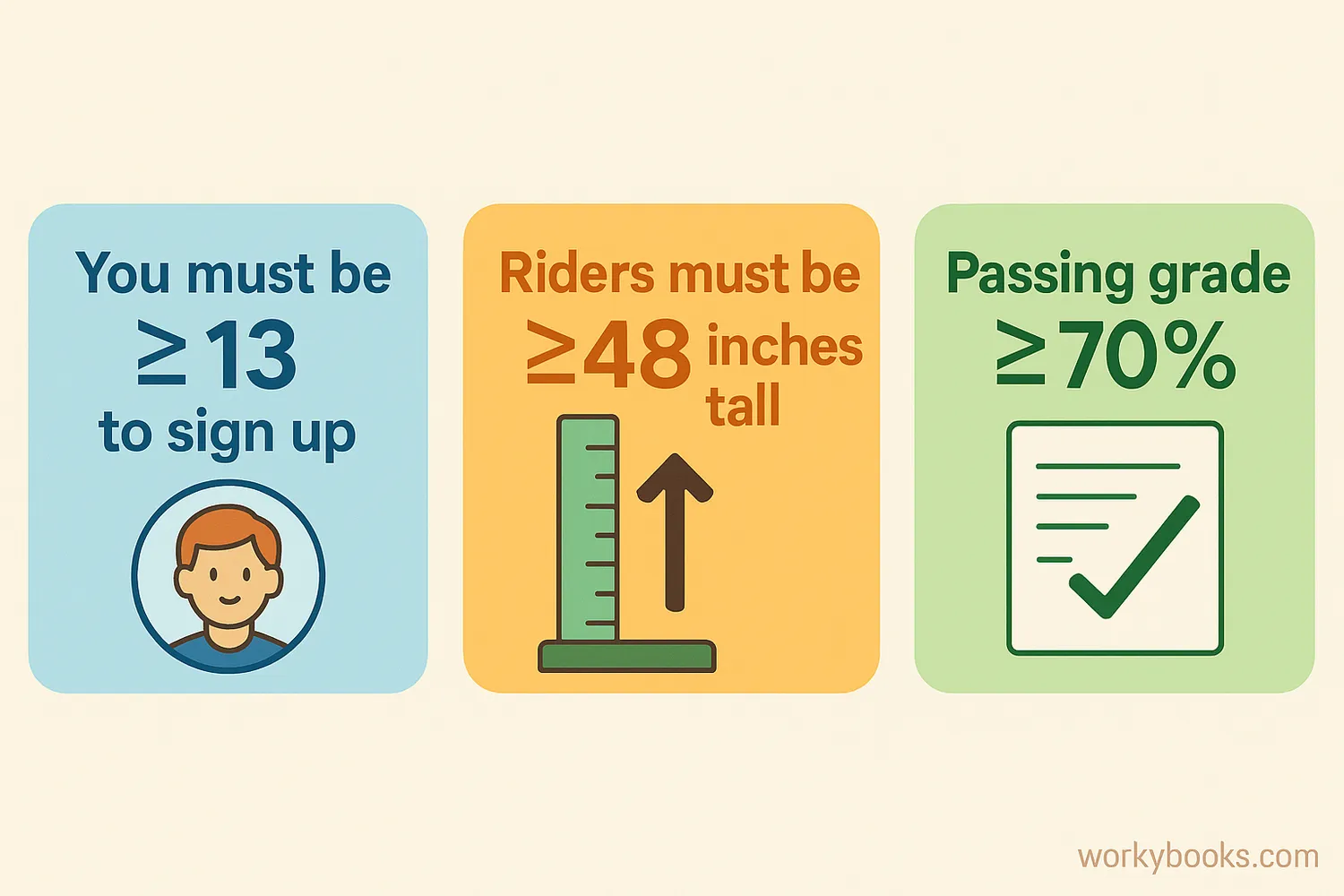Greater Than or Equal To - Definition, Examples, Quiz, FAQ, Trivia
Learn about inequality symbols with easy explanations, examples, and practice activities
What is Greater Than or Equal To?
The greater than or equal to symbol (≥) is a mathematical symbol used to compare two numbers or expressions. It shows that the value on the left is either greater than or equal to the value on the right.
Think of it like this: when you see 5 ≥ 3, it means "5 is greater than or equal to 3." Since 5 is greater than 3, this statement is true. When you see 4 ≥ 4, it means "4 is greater than or equal to 4." Since 4 equals 4, this statement is also true.
The symbol combines two ideas: the greater than symbol (>) and the equals symbol (=). The open side always faces the larger number, and the line underneath shows that equality is also possible.
Key Concept
The ≥ symbol means that the number on the left is either bigger than or the same as the number on the right.
How to Use the ≥ Symbol
Using the ≥ symbol is simple once you understand what it means. Follow these steps:
1. Identify the two numbers you want to compare
2. Determine if the left number is greater than the right number
3. Determine if the left number is equal to the right number
4. If either is true, you can use the ≥ symbol
Remember This Rule
Both conditions make the statement true.
Example: Is 7 ≥ 5 a true statement?
Step 1: Compare 7 and 5 → 7 is greater than 5
Step 2: Since 7 > 5, the statement 7 ≥ 5 is true
Another example: Is 6 ≥ 6 a true statement?
Step 1: Compare 6 and 6 → 6 equals 6
Step 2: Since 6 = 6, the statement 6 ≥ 6 is true
Remember
The ≥ symbol is only false when the number on the left is smaller than the number on the right.
Real-World Examples

We use the ≥ symbol in many real-life situations. Here are some examples:
Example 1: Age restrictions
"You must be ≥ 13 years old to sign up for this website."
This means you need to be 13 or older to join.
Example 2: Height requirements
"Riders must be ≥ 48 inches tall."
This means you need to be at least 48 inches tall to ride.
Example 3: Test scores
"A passing grade is ≥ 70%."
This means you need 70% or higher to pass.
Example 4: Shopping discounts
"Get free shipping on orders ≥ $50."
This means your order must be $50 or more to get free shipping.
Practice looking for these symbols in your daily life - you'll find them in stores, on websites, and in many other places!
Number Comparison Examples
| Statement | Is it true? | Explanation |
|---|---|---|
| 8 ≥ 5 | True | 8 is greater than 5 |
| 6 ≥ 6 | True | 6 is equal to 6 |
| 4 ≥ 7 | False | 4 is less than 7 |
| 10 ≥ 9 | True | 10 is greater than 9 |
| 3 ≥ 5 | False | 3 is less than 5 |
| 15 ≥ 15 | True | 15 is equal to 15 |
Practice Tip
When you see the ≥ symbol, remember it means "at least" or "no less than."
Practice Quiz
Test your understanding with this 5-question quiz. Choose the correct answer for each question.
Frequently Asked Questions
Here are answers to common questions about the greater than or equal to symbol:
Math Symbol Trivia
Discover interesting facts about math symbols:
Symbol Origin
The greater than (>) and less than (<) symbols were invented by British mathematician Thomas Harriot in his book "Artis Analyticae Praxis" published in 1631. The equal to (=) symbol was invented by Welsh mathematician Robert Recorde in 1557.
Universal Symbols
Math symbols like ≥ are used the same way in nearly every country around the world. Unlike words that change between languages, math symbols provide a universal language that mathematicians everywhere can understand.
Computer Programming
In computer programming, the ≥ symbol is often written as ">=" because many keyboards don't have the ≥ symbol. So programmers write "if (age >= 13)" instead of "if (age ≥ 13)".
Inequality Symbols
There are four main inequality symbols: > (greater than), < (less than), ≥ (greater than or equal to), and ≤ (less than or equal to). Each serves a different purpose in comparing values.





